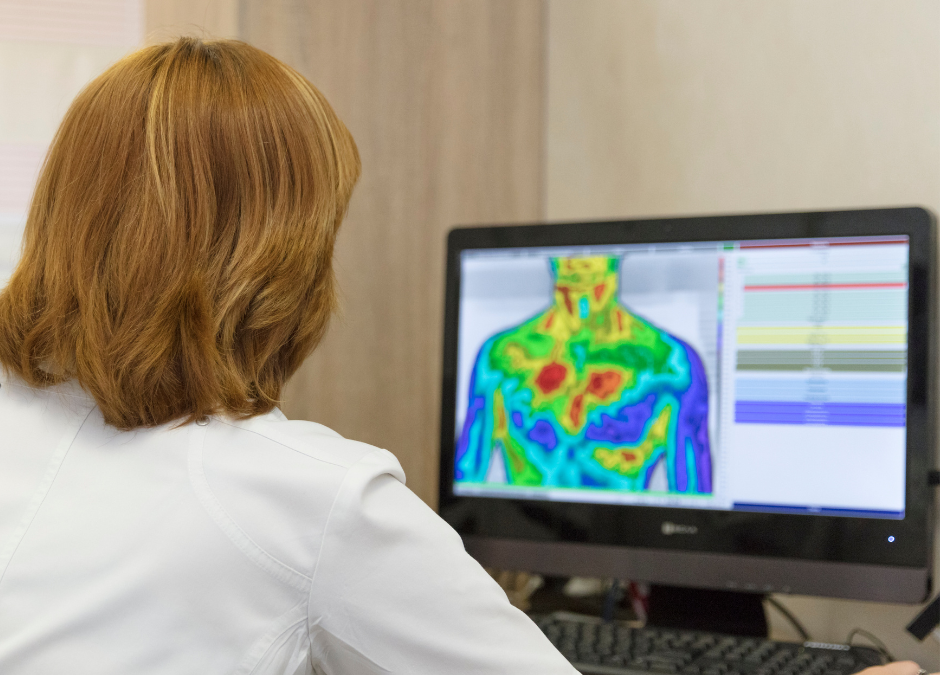In the world of medical imaging, there have been many advancements leading to major breakthroughs. One such advancement is Thermography – a non-invasive, radiation-free imaging technique that offers a unique window into our bodies’ inner workings.
What is Thermography, you ask? Let’s dive in!
Understanding Thermography
Thermography, also known as Digital Infrared Imaging (DII), capitalizes on the principle that every object emits infrared radiation based on its temperature. The technique involves the use of a highly sensitive infrared camera to capture and visualize these temperature variations on the surface of the body.
Unlike traditional medical imaging methods that focus on anatomical structures, Thermography emphasizes physiological changes that are often indicative of underlying health issues i.e. inflammation!
How is Thermography Performed?
The process of performing a Thermography scan is straightforward and non-invasive. Here’s a step-by-step breakdown of how it works:
- Preparation: Before the scan, avoid any factors that might alter skin temperatures, such as vigorous physical activity, caffeine, and extreme temperature exposure – this is very important to get an accurate reading.
- Image Capture: During the procedure, the patient stands or sits in a room with a controlled ambient temperature. An infrared camera is used to capture images of the body’s surface. These images display varying colors to represent different temperature levels, creating a visual map known as a thermogram.
- Analysis: A qualified thermographer analyzes the thermogram, identifying temperature asymmetries and anomalies. Any noticeable temperature differences could indicate areas of inflammation, circulation issues, or other underlying health concerns.
- Reporting: The results are compiled into a comprehensive report that provides insights into the patient’s thermal patterns. These patterns can be used as indicators of potential health conditions, serving as a valuable resource for healthcare practitioners to make informed decisions.
Benefits of Thermography
Thermography offers a ton of benefits that make it an attractive choice for both patients and healthcare providers:
- Early Detection: Thermography can detect physiological changes even before anatomical alterations are visible, allowing for early intervention and prevention.
- Radiation-Free: Unlike methods like X-rays and CT scans, Thermography doesn’t expose patients to ionizing radiation, making it a safer option for repeated imaging.
- Painless and Non-Invasive: The procedure is painless and doesn’t require any injections, contrast agents, or contact with the body.
- Full-Body Assessment: Thermography allows for a comprehensive assessment of the entire body, highlighting potential issues across various regions.
- Dynamic Insights: Thermal patterns can change over time, enabling the tracking of progress and response to treatment.
- Versatility: Thermography can be used for various applications, including breast health assessment, detecting inflammation, and evaluating nerve function.
Understanding Health Through Thermography
One of the most significant advantages of Thermography lies in its ability to provide insights into the body’s physiological state. Here are a few ways in which Thermography aids in understanding our health:
- Breast Health Assessment: Thermography is gaining recognition as an adjunctive tool for breast health evaluation. It can detect asymmetries and temperature variations that may indicate early signs of abnormal cell activity.
- Vascular and Circulatory Health: Thermal imaging can reveal circulation problems, such as impaired blood flow or inflammation, potentially identifying conditions like deep vein thrombosis.
- Inflammatory Conditions: Inflammation often manifests as increased temperature in the affected area. Thermography can be used to monitor the progression of inflammatory conditions such as arthritis or injuries.
- Nerve Function: Thermography can assess nerve function by identifying temperature differences along the nerve pathways, aiding in the diagnosis of conditions like neuropathy.
- Digestive Disorders: Temperature changes can indicate gastrointestinal issues like inflammation or dysfunction, providing insights into digestive health.
Contraindications and Considerations
While Thermography offers numerous benefits, there are certain factors to consider and potential contraindications.
While Thermography is valuable for identifying areas of concern, it is not a standalone diagnostic tool. Further testing and clinical correlation may be necessary to confirm findings. Pregnant women are also advised to postpone Thermography scans due to the potential temperature changes caused by hormonal fluctuations.
A Valuable Tool For Your Wellness
Thermography can help offer insights that extend beyond traditional anatomical evaluations. Its non-invasive nature, early detection capabilities, and ability to assess physiological changes make it a valuable tool for patients and practitioners alike. While it’s not without limitations and considerations, its potential to contribute to comprehensive health assessment and proactive wellness is undeniable!
